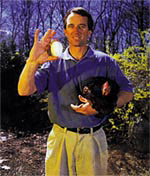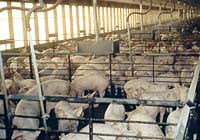With Thanksgiving nigh, the question arises: What is the meaning of sustainable cuisine?

Which came first? Kennedy with both a chicken and an egg.
The word sustainable expresses the obligation that each generation has to the next to preserve the value of the natural world. It does not mean we can’t use nature. Humankind, a predatory animal, is part of nature, and in my view the worst outcome of environmental advocacy would be if it resulted in separating human beings from nature. God wants us to use the bounty of the earth to enrich ourselves, to raise living standards, to build dignified vital communities, to savor life through all our senses, and to serve others — we just can’t use it up! We can live off the interest, but we can’t dip into the capital. This broad definition generally leaves me with a full plate. My own nature is to not be too careful about what I eat.
I avoid endangered species: monkey brains, shark fins, whale sushi, sea turtle, and Atlantic swordfish, which, but for its endangered status, is my favorite food. Otherwise, I’ll try almost anything on the menu or off the road. I’ve eaten all kinds of insects and nematodes, caterpillars, snakes, frogs, alligators, terrapins, sea urchins, octopus, birds eggs, a mouse (by mistake), wild game including armadillo, wildebeest, warthog, coons, and capybara, and some domestic animals including horse, dog, and guinea pig. I have eaten roadkill. I’m fond of viscera: tripe, tongue, brain, offal, sweet meats, pate, kidney pie, and sheep’s eyes. I even eat airline food. (Ironically, bad example has been the professor of good ethics; my son is a vegetarian and can hardly bear to sit with me at meals.)

Dog-licious?
Arguably, the most sustainable food is the hot dog because that’s where they put all the stuff that would otherwise go to waste. It’s like the Indians and the buffalo; they used all parts of the animal. Buffalo hot dogs might be the best bet. Among all ungulates, buffalo live on the prairies without destroying them. But most hot dogs are neither dogs nor buffalo but hogs — and, nowadays, that means industrial pork which, next to an endangered species, is the worst food on earth.
North Carolina’s hogs now outnumber its citizens and produce more fecal waste than all the people in California, New York, and Washington combined. Some industrial pork farms produce more sewage than America’s largest cities. But while human waste must be treated, hog waste, similarly fetid and virulent, is simply dumped into the environment. Stadium-sized warehouses shoehorn 100,000 sows into claustrophobic cages that hold them in one position over metal grate floors for a lifetime. Below, aluminum culverts collect and channel their putrefying waste into 10-acre, open-air pits three stories deep from which miasmal vapors choke surrounding communities and tens of millions of gallons of hog feces ooze annually into North Carolina’s rivers.
Such practices have created a nightmare like something out of science fiction. In North Carolina, the festering effluent that escapes from industrial swine pens has given birth to Pfiesteria piscicida, a toxic microbe that thrives in the fecal marinade of North Carolina rivers. This tiny predator, which can morph into 24 forms depending on its prey species, inflicts pustulating lesions on fish whose flesh it dissolves with excreted toxins, then sucks through a mouth tube. The “cell from hell” has killed so many fish — a billion in one instance — that North Carolina has had to use bulldozers to bury them beneath the rancid shores of the Neuse River and Pamlico Sound. Scientists suspect that Pfiesteria causes brain damage and respiratory illness in humans who touch infected fish or water. Three years ago, Pfiesteria sickened 36 fishermen and swimmers, as well as four state bridge workers who never even got damp.
Nobody Here But Us Chickens
Industrial poultry farming is also for the birds. Some corporate farms crowd a million beakless chickens in cramped dark cages where they soak up antibiotics and lay their guts out for the duration of their miserable lives. It’s hard to believe that people who run these animal concentration camps could enjoy happiness or dignity in their own lives.

Inside an industrial hog farm.
Photo: Environmental Interest Organization.
And the chickens are coming home to roost. Industrial farming isn’t just bad for chickens and hogs — it destroys family farms and pollutes aquifers, soils, air, and water. Billionaire chicken barons Don Tyson and Frank Perdue, like billionaire North Carolina hog tycoon Wendell Murphy, have used their market power to drive a million family farmers out of business, including nearly every independent egg and broiler farmer in America. Each corporate farm puts 10 family farmers out of business. The vertical integration these corporations push has bankrupted five out of six of America’s hog farmers over the past 15 years and pushed the final nail in the coffin of Thomas Jefferson’s vision of a democracy rooted in family-owned freeholds. Industrial meat moguls site their stinking farms in the poorest communities and pay slave wages to their minuscule work force for performing one of the most dangerous and unhealthy jobs in America.
Massive political contributions from this tiny handful of billionaire agriculture barons allow them to evade laws that prohibit other Americans from polluting our waterways. Industrial agriculture now accounts for over half of America’s water pollution. Two years ago, Pfiesteria outbreaks connected with wastes from industrial chicken factories forced the closure of two major tributaries of the Chesapeake and threatened Maryland’s vital shellfish industry. Tyson Foods has polluted half of all streams in northwestern Arkansas with so much fecal bacteria that swimming is prohibited. Drugs and hormones needed to keep confined animals alive and growing are mainly excreted with the wastes and saturate local waterways.
Moreover, industrial meat is unsavory. Factory-raised meat and pork are soft and bland. Factory chicken has been around long enough that people have forgotten how chicken should taste and most young people erroneously think you are supposed to be able to cut chicken with a fork.
Americans should look for free-range chickens from suppliers they trust and seek out local markets and producers who buy from sustainable family farms. There are still networks of farmers who raise their animals to range freely on grass pastures and natural feeds, who don’t use steroids, sub-therapeutic antibiotics, or other artificial growth promotants, and who treat their animals with dignity and respect. These farmers bring tasty premium quality meat to consumers while practicing the highest standards of husbandry and environmental stewardship.
Like many other Americans, I’ve reconciled myself to the idea that an animal’s life has been sacrificed to bring me a meal of pork or chicken. However, industrial meat and production — which subject animals to lives of torture — have escalated the karmic costs beyond reconciliation.
Plus, sustainable meats taste the best. This is a case where doing right means eating well.


